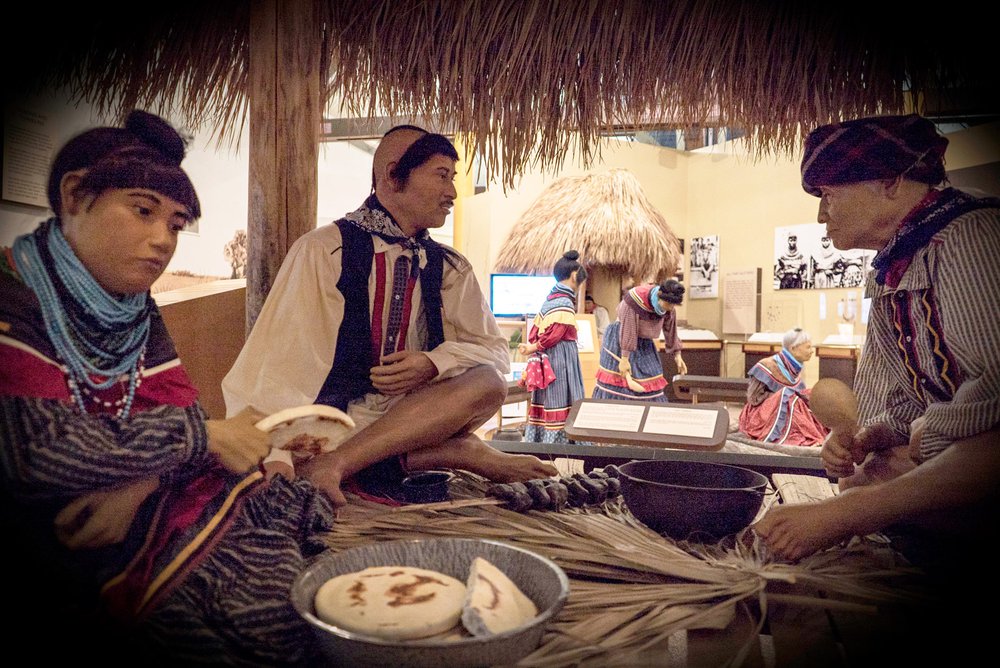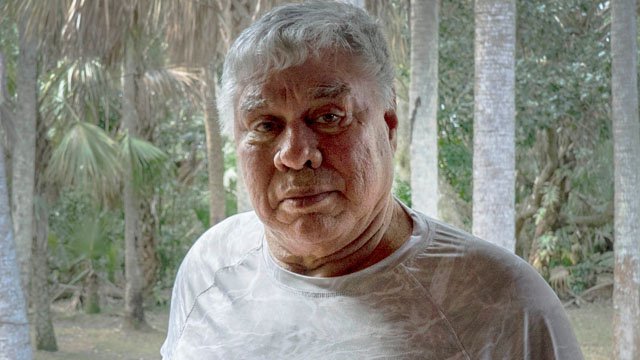
Carol was born in 1945 in a hospital in Miami. Carol is panther clan, like her mother, because that is how it works.
When Carol was small, it was all water and everything was clean. They didn’t drink from the water, but they went swimming and washed clothes in it. You saw cypress domes. You saw birds. That was it. Now everything is overgrown by plants that don’t belong. The birds have gone. The water is not clean like it was.
Carol was born in 1945 in a hospital in Miami. Carol is panther clan, like her mother, because that is how it works.
When she was little, Carol lived around the trail that was built in 1928, and the Indians had left their islands to go live by it. They made camp on paths that the road-builders carved to keep equipment.
Carol’s family spent a lot of time at the camp of her grandfather, Billy Osceola. His camp was along county road 29, which leads from the Everglades to Immokalee, all the way to LaBelle. He made and sold canoes. Carol used to ride around and play in them. But she didn’t use them to get anywhere. There were roads and vehicles for that. Not that they had a car themselves. They’d borrow one, or someone would clean out the cattle trucks and everyone would go to town.
Carol’s father hunted for frog legs and alligator skins and meat to sell to the restaurants. He took jobs wherever he could. He started farming along the trail — potatoes and tomatoes. He picked vegetables at Copeland. At Copeland, they also used to harvest cypress trees, but the supply dwindled and the company moved out.
Carol’s mother started sewing and making dolls and baskets. They called the dolls “picture of yourself.” The kids weren’t allowed to play with them. They were for selling at tourist attractions like Tropical Happyland and Musal. They brought the tourists in on boats to see the Indians and the animals. Carol wasn’t going to school at the time, so she’d go with her mother. One time, they went down to Miami to sew in the display window at Burdines department store. They were promoting patchwork.
That’s how life was, moving from one camp to another, wherever her parents could find work. Hochapee to Copeland, Immokalee to Big Cypress. Wherever they went, they were with family. They stayed in someone’s chickee. The chickee didn’t have walls back then; to sleep, they wrapped themselves in mosquito net. Children slept with their parents. Teenage boys moved out, as did girls who started their periods. Girls with their periods were not allowed to eat with the family.

For food, they mostly hunted. It was the ‘50s and you could still live off the land. When they did go to town to shop they got 20 pound bags of flour and rice, sugar and coffee, plus cooking oil, salt, and fabric for sewing. A luxury food was cookies, canned peaches or apples. They were careful in town. LaBelle was friendly. Clewiston wasn’t that friendly, and they only went to certain stores in Immokalee. A lot of places wouldn’t let you in. At others, you might touch something and be accused of stealing. When Carol’s grandparents came to town, they stayed in the car.
It wasn’t until they moved to Dania that Carol started going to school. She was eight or nine. In her father’s time, they weren’t allowed to go to school. The tribe didn’t want them to learn English. But the world had changed. Carol’s father knew his children needed the other society’s education to survive. So he pushed them to go.
Carol had never worn shoes before. She had never worn underwear either. These were new things, white people things. So was naptime. She had always been taught not to lay around in chickees. Nobody wanted to marry a girl who was lazy and sleeping all the time. They got up in the morning and went to sleep when the sun went down. But at school, she was told that she had to take a nap after lunch. She couldn’t; it was not how she was raised. So she sat up. She heard them talking about how she was causing trouble. They didn’t understand.
But that was not as bad as other stories she heard later. There was one man who was older than her that had gone to her same school. When he went, they dropped the white kids off first and took the Indian kids to be powdered down for lice. What he remembered was the shame. He told Carol he hated white people. In any case, they had stopped doing it by the time Carol started.
She can’t remember when she started to learn English. Her first book was Run Spot, Run. She liked learning. You could go places in books that you could never visit in real life. But when she came back home, she spoke her language.
It was two different worlds. In high school, Carol took the bus to Clewiston, but she didn’t spend much time there. She didn’t socialize with the other students, and she was comfortable with that. On Saturdays and holidays, she worked out in the fields, picking tomatoes, cucumbers, beans and green pepper. Back in Clewiston for school, she’d take her pay to the dime stores and buy what she needed — a comb, underwear, anything like that. Her father encouraged her to spend her own money. He just asked that she tithed some of what she earned at church.

Carols’s parents were Christian, and her grandparents eventually became Christian, too. Carol saw no contradiction in observing Indian traditions and going to church. The only tension there was created by white people.
Carol’s husband, Billy Cypress, was a Christian, too. She knew him all her life, but it didn’t start with them until 1966. She was graduating from high school and he was going to Stetson University. In the summers, he’d come back to the reservation. One evening, she was sitting on a swing. He came over to talk and he started pushing it. He asked if she was going to the prom. She said no because she didn’t have anyone to take her. He said he would. She didn’t expect him to and forgot all about it. Later, she got a letter. He wouldn’t be able to take her after all; he was in the Navy and about to ship out. She wishes she could find that letter now.
When he came back, Billy started living with his best friend James, who was dating Carol’s sister. Billy was a serious person. He read everything under his little lantern. He was a nerd, but Carol liked him. They started going together in February; by August, they were married.
Billy and James had a dream to build a museum to preserve and celebrate Seminole culture. Then James became chairman. It took a long time, but they finally built the museum in 1997. James asked Billy to be the first director.
Today, when Carol sits in the museum, she is surrounded by family. There is her son, in a traditional turban made from wool shawls. There is her grandfather, carving a canoe. There is a world that does not exist anymore — except in dreams and memories.













